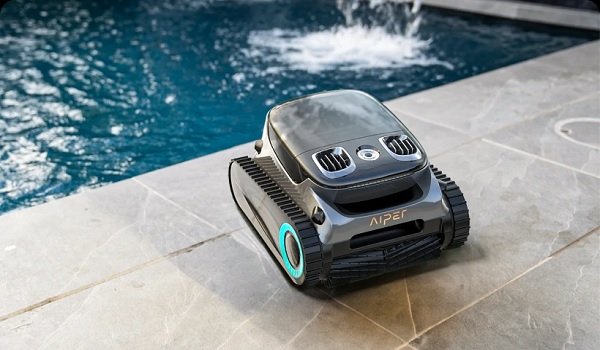The Manual Skimming Era: A Labor-Intensive Beginning

Before the advent of advanced pool cleaning technologies, manual skimming was the primary way to remove debris from a pool. This involved using a long-handled net, often requiring daily effort to maintain clear water. While effective at capturing floating debris, this method came with several downsides:
- Time-Consuming: For larger pools, manual skimming could take upwards of an hour each day.
- Inefficient for Sunk Debris: Skimming only addressed surface-level debris, leaving sunken leaves and dirt untouched.
- Labor-Intensive: The repetitive motion of skimming was physically demanding and could lead to fatigue or strain.
Despite its drawbacks, manual skimming was the norm for years, largely because there were no other viable alternatives. This began to change with the introduction of basic mechanical pool cleaners.
The Rise of Automatic Pool Cleaners: A Game-Changer
In the mid-20th century, the first automatic pool cleaners entered the market. These devices used suction from the pool’s pump to navigate the pool floor and walls, removing dirt and debris. While they didn’t entirely replace the need for manual skimming, they significantly reduced the time and effort required for pool maintenance.
Advantages of Early Automatic Pool Cleaners:
- Improved Cleaning Efficiency: By handling dirt on the pool floor and walls, they complemented manual skimming efforts.
- Reduced Manual Labor: Homeowners could focus on surface debris while the cleaner handled submerged areas.
- Ease of Use: Most models required minimal setup and could operate while the pool was not in use.
Although these early models were groundbreaking, they were still dependent on the pool’s filtration system and couldn’t handle floating debris. This gap paved the way for further innovations in pool cleaning technology.
The Age of Robotic Pool Cleaners: The Fully Automated Solution
The robotic pool cleaner revolutionized pool maintenance by offering a comprehensive cleaning solution. Unlike their predecessors, robotic cleaners operate independently of the pool’s filtration system, using their motors and filtration systems. Many modern models are designed to clean not only the pool floor and walls but also address surface debris, significantly reducing the need for manual skimming.
How Robotic Pool Cleaners Work:
- Autonomous Navigation: Equipped with smart sensors and navigation systems, robotic cleaners map the pool’s layout and clean efficiently.
- Multi-Surface Cleaning: They scrub the pool floor, walls, and in some cases, even the waterline, ensuring a thorough clean.
- Debris Filtration: Modern robotic cleaners feature internal filters that trap debris, from large leaves to fine particles, without burdening the pool’s filtration system.
Can Robotic Pool Cleaners Fully Eliminate Manual Skimming?
While robotic pool cleaners are certainly efficient, whether robotic skimming can replace manual skimming is a slightly different story. For example, if you have one of the more expensive robotic cleaners that can clean your pool’s waterline and capture floating debris, most robotic cleaners are intended to clean your pool’s floor and walls. However, that means surface cleaning may not always be their forte.
However, environmental conditions also play a part. Leaves may fall heavily into pools close to trees or located near areas prone to high winds. In these cases, even the best robotic cleaner may need to be assisted by a skimmer or some manual cleaning every now and then. In addition, regular pool use can bring surface contaminants such as oils and lotions that require the use of specialised cleaning tools.
Although robotic cleaners are great, many Australian pool owners will do well with a combination of robotic cleaning and a manual or solar-powered skimmer. With this hybrid method in place, maintenance efforts are minimized while your pool’s parts are always pristine and inviting. It hits that sweet spot—it’s convenient enough without tiring of its thoroughness.
The Role of Solar-Powered Skimmers in Modern Pool Maintenance
A relatively new addition to the pool cleaning arsenal, solar-powered skimmers are designed to collect floating debris autonomously. These devices use solar energy to glide across the pool’s surface, collecting leaves, insects, and other contaminants. While they are not a substitute for robotic pool cleaners, they can complement them by addressing surface-level debris.
Advantages of Solar-Powered Skimmers:
- Eco-Friendly: Powered by renewable energy, these skimmers are an environmentally conscious choice.
- Reduced Energy Costs: Unlike traditional pool equipment, solar skimmers do not rely on electricity, reducing operating costs.
- Autonomous Operation: Solar skimmers work continuously during the day, keeping the pool surface clean.
Pairing a solar skimmer with a robotic pool cleaner ensures comprehensive cleaning, from the waterline to the pool floor.
Conclusion
The evolution of pool cleaning has transformed what was once a labor-intensive chore into a streamlined, automated process. From the days of manual skimming to the modern era of robotic and solar-powered cleaners, pool owners now have access to tools that save time, reduce effort, and enhance the overall swimming experience.
While no single device can entirely replace manual skimming in every situation, combining a robotic pool cleaner with a solar-powered skimmer can provide a near-seamless cleaning solution. By investing in the best pool cleaner for your needs, you can enjoy a sparkling, low-maintenance pool year-round—perfect for making the most of Australia’s sunny climate.




